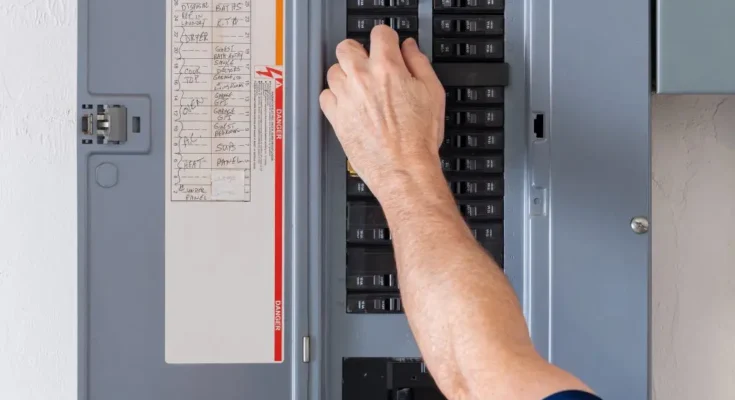Introduction:
The electrical panel is the heart of any home’s electrical system, responsible for distributing power to various circuits and ensuring safety by regulating electrical currents. However, as homes age and electrical demands evolve, the need for an electrical panel upgrade becomes increasingly apparent. Knowing when to upgrade an electrical panel is crucial for maintaining safety, efficiency, and functionality within your home. In this comprehensive guide, we’ll explore the signs that indicate it’s time for an electrical panel upgrade, the benefits of upgrading, and the steps involved in the upgrade process.
Signs It’s Time for an Electrical Panel Upgrade:
Overloaded Circuits: One of the most common signs that your electrical panel needs an upgrade is overloaded circuits. If you frequently experience tripped circuit breakers or blown fuses, it’s a clear indication that your electrical panel is struggling to handle the load. Overloaded circuits not only inconvenience you but also pose a significant safety risk, as they can lead to electrical fires if left unaddressed.
Outdated Panel: Homes built several decades ago may still have electrical panels that are outdated and unable to meet modern electrical demands. If your electrical panel uses fuses instead of circuit breakers or lacks the capacity to accommodate additional circuits, it’s time to consider an upgrade. Older panels are more prone to malfunction and may not offer the same level of protection as newer models.
Insufficient Capacity: As technology advances and households acquire more electronic devices and appliances, the demand for electricity continues to rise. If you find yourself constantly running out of electrical outlets or needing to unplug devices to avoid overloading circuits, it’s a sign that your electrical panel’s capacity is insufficient. Upgrading to a larger panel with greater capacity can alleviate these issues and provide room for future expansion.
Home Renovations or Additions: Planning a home renovation or addition is an opportune time to assess the adequacy of your electrical panel. Adding new rooms, appliances, or electrical fixtures increases the load on your electrical system and may necessitate an upgrade to ensure compatibility and safety. It’s best to address any necessary upgrades before beginning construction to avoid disruptions and ensure compliance with building codes.
Age of the Panel: Like all components of your home, electrical panels have a finite lifespan and will eventually require replacement. If your electrical panel is approaching or exceeds its expected lifespan (typically 25-40 years), it’s wise to proactively consider an upgrade, even if you haven’t experienced any noticeable issues. Aging panels are more prone to failure and may lack modern safety features found in newer models.
Benefits of Upgrading Your Electrical Panel:
Enhanced Safety: Perhaps the most significant benefit of upgrading your electrical panel is enhanced safety. Modern panels are equipped with advanced safety features such as arc fault circuit interrupters (AFCIs) and ground fault circuit interrupters (GFCIs) that help prevent electrical fires and shocks. By upgrading your panel, you reduce the risk of electrical hazards and protect your home and loved ones.
Increased Capacity: Upgrading your electrical panel allows you to increase the capacity of your electrical system, providing ample power for all your electrical needs. Whether you’re adding new appliances, expanding your home, or simply seeking to accommodate modern technology, a larger panel ensures that you have sufficient electrical capacity without overloading circuits.
Improved Energy Efficiency: Newer electrical panels are designed to operate more efficiently, reducing energy waste and lowering utility bills. Features such as smart meters and energy monitoring systems enable you to track your energy usage and identify opportunities for savings. By upgrading your panel, you not only improve safety and capacity but also contribute to a more sustainable and cost-effective home.
Compatibility with Smart Home Technology: With the proliferation of smart home devices and automation systems, compatibility with modern technology is increasingly important. Upgrading your electrical panel ensures compatibility with smart home devices and allows you to take full advantage of their capabilities. Whether you’re installing smart thermostats, lighting controls, or security systems, a modern electrical panel provides the foundation for seamless integration.
Compliance with Building Codes: Building codes and regulations governing electrical systems are constantly evolving to reflect advances in technology and safety standards. By upgrading your electrical panel, you ensure compliance with current building codes and regulations, reducing the risk of fines or penalties for non-compliance. Additionally, a compliant electrical system enhances the resale value and marketability of your home, providing peace of mind to prospective buyers.
The Electrical Panel Upgrade Process: Once you’ve determined that an electrical panel upgrade is necessary, it’s essential to understand the steps involved in the upgrade process:
Consultation and Assessment: Begin by consulting with a licensed electrician who can assess your current electrical panel and discuss your specific needs and preferences. They will evaluate the condition of your existing panel, determine the appropriate size and type of panel for your home, and provide recommendations for upgrades.
Permitting: In many jurisdictions, electrical panel upgrades require permits from local authorities to ensure compliance with building codes and regulations. Your electrician will handle the necessary permitting process and ensure that all work is performed according to the applicable codes and standards.
Panel Selection and Installation: Once permits are obtained, the next step is to select a new electrical panel and schedule the installation. Your electrician will disconnect power to your home, remove the old panel, and install the new panel in its place. This may involve upgrading wiring, installing additional circuits, or making other modifications to accommodate the new panel.
Circuit Testing and Certification: After the new panel is installed, your electrician will conduct thorough testing to ensure that all circuits are functioning properly and safely. This includes testing for proper voltage, grounding, and circuit integrity to verify compliance with regulatory requirements. Once testing is complete, your electrician will provide certification documenting the successful installation and compliance with all applicable standards.
Final Inspection and Approval: Depending on local regulations, a final inspection may be required to verify that the electrical panel upgrade meets all code requirements. Your electrician will coordinate with the relevant authorities to schedule the inspection and ensure that any necessary corrections or adjustments are made to achieve final approval. Once the upgrade is approved, power will be restored to your home, and you can enjoy the benefits of your new electrical panel.
Conclusion:
Knowing when to upgrade your electrical panel is essential for maintaining safety, efficiency, and functionality within your home. By recognizing the signs that indicate it’s time for an upgrade, understanding the benefits of upgrading, and following the upgrade process outlined in this guide, you can ensure that your home’s electrical system remains reliable and secure for years to come. Whether you’re experiencing overloaded circuits, planning a home renovation, or simply seeking to enhance safety and efficiency, an electrical panel upgrade is a wise investment that pays dividends in comfort, convenience, and peace of mind.




